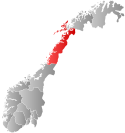|
Dverberg Municipality
Dverberg is a former municipality in Nordland county, Norway. The administrative centre was the village of Dverberg where Dverberg Church is located. The municipality existed from 1838 until its dissolution in 1964. The municipality encompassed the central areas on the island of Andøya in what is now Andøy Municipality. Starting out at about 616 square kilometres (238 sq mi) in 1838, it was reduced in size in 1924. Upon its dissolution in 1964, the municipality was only 279 square kilometres (108 sq mi). [6][7] Prior to its dissolution in 1964, the 279-square-kilometre (108 sq mi) municipality was the 296th largest by area out of the 689 municipalities in Norway. Dverberg Municipality was the 500th most populous municipality in Norway with a population of about 1,681. The municipality's population density was 6 inhabitants per square kilometre (16/sq mi) and its population had increased by 0.4% over the previous 10-year period.[8][9] General information  The historic prestegjeld of Dverberg was established as a municipality on 1 January 1838 (see formannskapsdistrikt law). It originally included the whole island of Andøya as well as about 100 square kilometres (39 sq mi) on the northeastern tip of the large island of Hinnøya, plus a number of very small surrounding islets.[7][10] On 1 January 1924, Dverberg Municipality was divided into three. The northern part of Dverberg became the new Andenes Municipality (population: 2,213) and the southern part of Dverberg Municipality was separated to become the new Bjørnskinn Municipality (population: 1,410). This left 1,477 residents in Dverberg Municipality which now only covered the central part of the island of Andøya.[10] During the 1960s, there were many municipal mergers across Norway due to the work of the Schei Committee. On 1 January 1964, Dverberg Municipality (population: 1,719) was merged (back) with the neighboring Bjørnskinn Municipality (population: 1,835) and Andenes Municipality (population: 3,812) to create the new Andøy Municipality[6][10] NameThe municipality (originally the parish) is named after the old Dverberg farm (Old Norse: Dvergaberg) since the first Dverberg Church was built there. The first element is dvergr which means "dwarf". The last element is berg which means "mountain". Thus the name is referring to a mountain where dwarfs live.[11] ChurchesThe Church of Norway had one parish (sokn) within Dverberg Municipality. At the time of the municipal dissolution, it was part of the Dverberg prestegjeld and the Vesterålen prosti (deanery) in the Diocese of Sør-Hålogaland.[9]
GeographyThe highest point in the municipality is the 620.2-metre (2,035 ft) tall mountain Ressmålstinden.[1] The municipality was located in the central part of the island of Andøya. Andenes Municipality was located to the north and Bjørnskinn Municipality was located to the south. The Andfjorden was located to the east and the Norwegian Sea was located to the west of the municipality. GovernmentWhile it existed, Dverberg Municipality was responsible for primary education (through 10th grade), outpatient health services, senior citizen services, welfare and other social services, zoning, economic development, and municipal roads and utilities. The municipality is governed by a municipal council of directly elected representatives. The mayor is indirectly elected by a vote of the municipal council.[12] The municipality was under the jurisdiction of the Hålogaland Court of Appeal. MayorsThe mayor (Norwegian: ordfører) of Dverberg was the political leader of the municipality and the chairperson of the municipal council. Here is a list of people who held this position:[13]
Municipal councilThe municipal council (Herredsstyre) of Dverberg was made up of 15 representatives that were elected to four year terms. The tables below show the historical composition of the council by political party.
Notable people
See alsoReferences
|
||||||||||||||||||||||||||||||||||||||||||||||||||||||||||||||||||||||||||||||||||||||||||||||||||||||||||||||||||||||||||||||||||||||||||||||||||||||
Portal di Ensiklopedia Dunia


